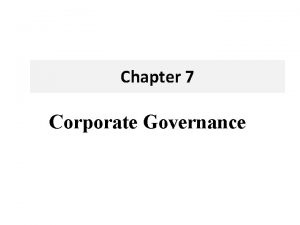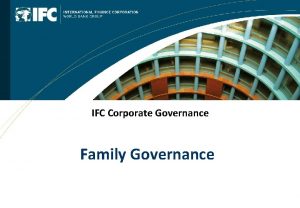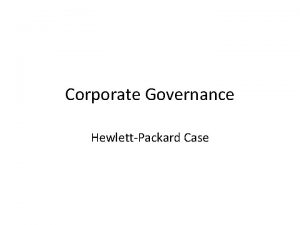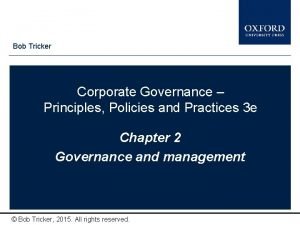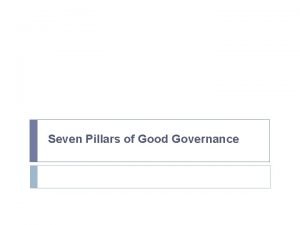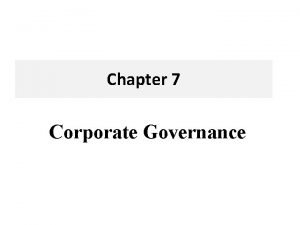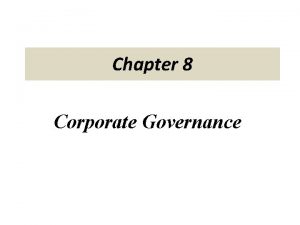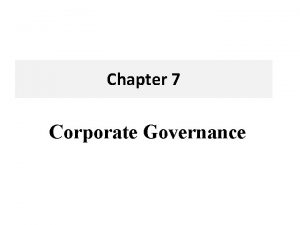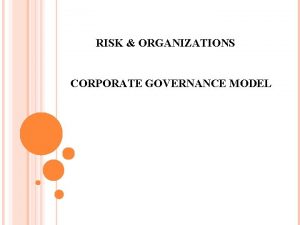Chapter 7 Corporate Governance Definition of Corporate governance




















- Slides: 20

Chapter 7 Corporate Governance

Definition of Corporate governance • “Corporate governance involves a set of relationships between a company’s management, its board, its shareholders and other stakeholders. . also the structure through which objectives of the company are set, and the means of achieving those objectives and monitoring performance are determined. ” • Focused on preventing corporate collapses such as Enron collapse. 2

Corporate governance Corporate Governance aims : 1. Define relationships between a company’s management, its board, shareholders and other stakeholders. 2. Provide a structure through which the company’s objectives are set, and how they are achieved and monitored. 3. Recognize the value of business ethics and corporate awareness of society interests to reputation and longterm success. 3

Benefits of Corporate Governance? 1. Better access to external finance. 2. Lower costs of capital – interest rates on loans. 3. Improved company performance – sustainability. 4. Higher firm evaluation and share performance. 5. Reduced risk of corporate crisis and scandals. 4

Corporate Governance • Contemporary corporate governance started in 1992 with the Cadbury report in the UK. • Cadbury report was the result of several high profile company collapses. • Sir George Adrian Cadbury was a Director of the Bank of England from “ 1970– 1994”. • He was Chairman of the UK Committee on the Financial Aspects of Corporate Governance which published its Report and Code of Best Practice (Cadbury Report and code of Best Practice) in December 1992. 5

Cadbury • https: //www. youtube. com/watch? v=Zf. C 7 yk. LK y 4 M 6

Cadbury Report 1992 • The Cadbury Report: titled Financial Aspects of Corporate Governance, is a report of a committee chaired by Adrian Cadbury that sets out recommendations on the arrangement of company boards and accounting systems to lessen corporate governance risks and failures. • The report's recommendations have been adopted in varying degree by the European Union, the United States, and others. 7

Cadbury Report Recommendations 1. 2. 3. 4. 5. 6. Wider use of independent directors. Introduction of audit committee. Separation between Chairman and CEO. Protect rights of Shareholders. Recognize the rights of Stakeholders. Timely and accurate Disclosure. 8

Corporate Governance Parties 1. Shareholders : those that own the company. 2. Directors : Guardians of the Company’s assets for the Shareholders. 3. Managers: who use the company’s assets. 9

Four Principals of Corporate Governance 1. Accountability. 2. Fairness. 3. Transparency. 4. Independence. 10

1. Accountability • Ensure that management is accountable to the Board of Directors. • Ensure that the Board of Directors is accountable to shareholders. 11

2. Fairness • Protect Shareholders rights. • Treat all shareholders including minorities, equitably. • Provide effective redress for violations. 12

3. Transparency • Ensure timely, accurate disclosure on all material matters, including the financial situation, performance, ownership and corporate governance. 13

4. Independence • Independent Directors and Advisers. i. e. free from the influence of others. 14

Elements of Corporate Governance 1. Good Board practices. 2. Control Environment. 3. Transparent Disclosure. 4. Well-defined shareholder rights. 5. Board Commitment. 15

1. Good Board Practices • Clearly defined roles and authorities. • Board is well structured. • Appropriate Board procedures. • Director compensation in line with best practice. • Board self-evaluation and training conducted. 16

2. Control Environment • Internal control procedures. • Independent external auditor conducts audits. • Independent audit committee established. • Internal Audit Function. • Management Information systems established. 17

3. Transparent Disclosure • Financial Information disclosed. • Non-Financial Information disclosed. • Financials prepared according to International Financial Reporting Standards (IFRS). • Companies Registry filings up to date. • High-Quality annual report published. 18

4. Well-Defined Shareholder Rights • Minority shareholder rights formalized. • Well-organized shareholder meetings conducted. • Policy on extraordinary transactions. • Clearly defined and explicit dividend policy. 19

5. Board Commitment • The Board has created a corporate governance committee. • The company has a corporate governance champion. • Appropriate resources are committed to corporate governance initiatives. • Policies and procedures have been formalized and distributed to relevant staff. • The company is recognized as a corporate governance leader. 20
 Objective of corporate governance
Objective of corporate governance Chapter 10 corporate governance
Chapter 10 corporate governance What is corporate governance
What is corporate governance Corporate governance definition
Corporate governance definition Oecd corporate governance definition
Oecd corporate governance definition Corporate governance oecd
Corporate governance oecd Sociological theory of corporate governance
Sociological theory of corporate governance Tax assurance
Tax assurance Corporate governance chain
Corporate governance chain Informational and behavioral control
Informational and behavioral control Isu dan riset kontemporer corporate governance
Isu dan riset kontemporer corporate governance Features of corporate governance
Features of corporate governance Family governance definition
Family governance definition Corporate governance in sri lanka
Corporate governance in sri lanka Corporate governance code of maldives
Corporate governance code of maldives Hp corporate governance
Hp corporate governance P&g corporate governance
P&g corporate governance Staggered board structure
Staggered board structure Scope of corporate governance
Scope of corporate governance Corporate governance is which approach
Corporate governance is which approach 7 pillars of good governance
7 pillars of good governance


